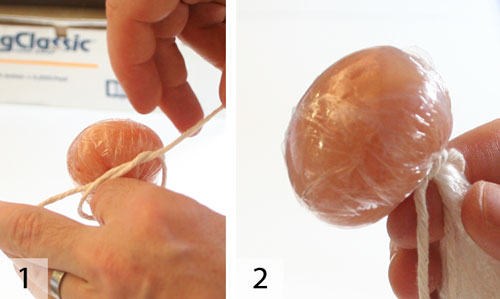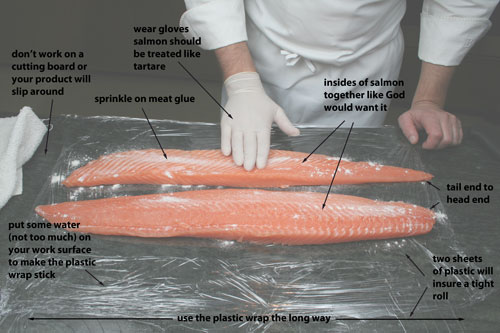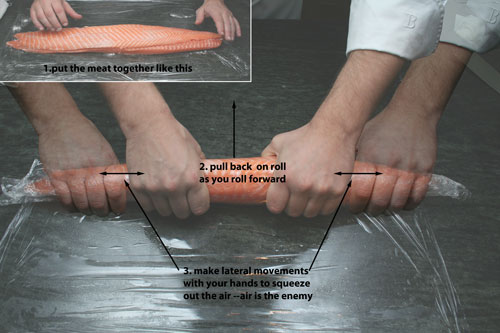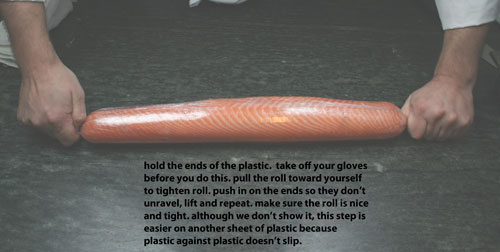posted by Dave Arnold
Low-Temperature and Sous-Vide Primer Contents:
- Purdy Pictures: Sous-Vide and Low-Temp Charts
- I . Introduction to Low-Temperature Cooking and Sous-Vide
- **II. Low-Temperature Cooking Without a Vacuum** you are here
- III. Use and Abuse of the Vacuum Machine andVacuum Tricks
- IV. Temperature Control and Safety
- V. Cooking Meats and Poultry
- VI. Cooking Fish
- VII. Cooking Everything Else
Part II. Low-Temperature Cooking Without a Vacuum
… in which we’ll discuss preparing foods for low-temperature cooking without using a vacuum machine. We’ll look at zip-loc bags, plastic wrap, and cooking in oil/stock/humid air.
- 1. Introduction: Why You’d Want to Do Low-Temp Cooking Without a Vacuum
- 2. Unprotected Cooking Techniques
- 3. Protected Low-Temperature Cooking
Introduction
Before We Start: A Note from New York City:
In New York City, a restaurant cannot use a vacuum machine without developing a HACCP plan. HACCP (Hazard Analysis Critical Control Points) is a system designed to ensure food safety. It was developed by large corporations who were making food for space missions –giving an astronaut food poisoning can be catastrophic. Creating your own HACCP plan (explained in the upcoming safety section of the primer), even if you don’t implement it fully, is a great way to help yourself ensure food safety. HACCP plans administered by the Board of Health, on the other hand, are a pain in the rear. They entail extra inspections, log books, lots of time, and possibly spending money on consultants. Look here for the Board of Health guidelines. Low temperature techniques that do not require a vacuum machine have a major advantage for New Yorkers: no HACCP plan required.
Even If You Don’t Cook in New York City:
While I love a commercial vacuum machine, about 90% of what a cook wants to accomplish with low temperature cooking can be achieved without a vacuum machine. When Nils was at restaurant Aquavit he did a lot of low-temperature work with a circulator, but didn’t have a vacuum machine. Back then restaurants weren’t required to have a HACCP plan; he didn’t have a commerical vacuum because they cost too much.
Today many home cooks use the Food Saver vacuum for low temp. I don’t use my Food Saver any more. I use Ziploc bags, without a vacuum. I find Ziplocs easier than the Food Saver – I don’t have to hunt down the special bags, I can easily bag sauces (a pain with the Food Saver), I can bag hot foods (foods to be vacuumed need to be cold – more on that in the next primer installment). My Food Saver has been relegated to potato-chip-bag-resealer.
To Review:
Low temperature cooking is defined as any cooking procedure where the cooking temperature is at, or close, to the desired final internal temperature. There are two requirements for low-temperature cooking:
- precise and accurate temperature control
- a cooking medium which conducts heat more efficiently and accurately than dry air. Water and water vapor are typical; oil, stock, or any other liquid will work (for more info, see Part I).
The Basics: To Pack or Not To Pack
There are two basic approaches to low temperature cooking:
- Expose the food to the cooking environment – includes cooking in temperature controlled poaching liquids, oil, 100% humid air. I call this “unprotected” low temp.
- Protect the food from the cooking environment – includes vacuum bagging (covered in the next installment of the primer), Ziploc bagging, plastic wrapping.
2. Unprotected Cooking Techniques:
You can’t cook low-temperature in dry air; for example, don’t try it in your oven. Dry air is a poor heat conductor and causes evaporative cooling at the surface of your food – making accurate temperature control impossible. 100% humid environments, like you can achieve in a combi oven, don’t conduct heat as well as straight water, but they can be very accurate. This kind of cooking is simple. Food goes into the cooker and gets pulled when it’s done; no wrapping required. The workflow is very intuitive for most cooks. But there are some disadvantages to 100% humid cooking; if you’re doing a cook-chill procedure the food isn’t protected from recontamination (it would be if it was wrapped); and during long cooking times (like several hours) the food’s surface tends to degrade.
Combi ovens and CVap ovens provide a 100% humid environment:
Combi ovens are combination steam/convection ovens; modern ones can operate at low temperatures. The main advantage of combi ovens: they can handle large amounts of food without getting bogged down by overloading, or by repeated opening and closing. Unfortunately, the ovens expend an enormous amount of energy to maintain this stability. Combis are also expensive and difficult to retrofit into many kitchens. And perhaps their biggest problem: they aren’t very accurate. Studies by Chris Young and Nathan Myhrvold show that while a combi oven’s average temperature can be accurate to within a couple of degrees centigrade, at any one moment it can be tens of degrees off. Combis should only be used to cook large items , like roasts, that won’t overcook in the ten minutes or so that it takes the combi to swing back and forth around its target temperature.
CVap technology was originally developed for Kentucky Fried Chicken. Colonel Sanders needed something that would hold his chicken in perfect condition; he asked his friend and fryer guru, Winston L. Shelton, for help. In response, Shelton invented CVap (Controlled Vapor) technology. CVap ovens are basically food holding cabinets with a bain marie in the bottom. Both the oven cavity and the bain marie are heated and temperature controlled. The cook can control the humidity inside the oven by adjusting the difference in temperature between the bain marie and the oven air. The core temperature of the food will not rise above the temperature of the bain marie. The surface texture of the food is controlled by the humidity of the oven air. You set the temperature of the oven air much higher than the water for crispy foods, like fried chicken, and you set it the same temperature for low temp cooking. For a detailed discussion of why the CVap works, see here.
The Cvap comes in a range of sizes, is much cheaper than a combi, doesn’t require a lot of power, doesn’t require a water supply or a drain, and is extremely easy to retrofit. Many restaurants in New York City bought CVaps immediately after the Health Department instituted HAACP control for sous-vide cooking. It is difficult to get a HAACP plan approved for sous-vide fish, and it is impossible to get one approved for fish below pasteurization temperatures (which is where we usually want to cook it). Since the possibilities of low temperature fish attracted many chefs to low temperature cooking in the first place, many took up the CVap. It was basically unheard of in chef circles prior to the health department crack down. The disadvantage of the CVap: it can start sucking wind if overloaded, or if the door is frequently opened and closed.
Cooking Directly in Water/Fat/Stock/Poaching Liquid
The immersion circulator is many cooks’ instrument of choice for low temperature cooking; most cooks only use their immersion circulator with water. Take note: you can circulate any liquid you want –stock, beer, oil, duck fat, lard, apple cider, whatever. I am often asked if the circulator will be damaged by liquids other than water. Happily, the answer is No. If you ask Philip Preston from Polyscience (whose circulators we use) he will tell you the machines aren’t NSF rated for direct food contact. It isn’t because the circulators aren’t safe for direct food contact, it’s just that getting the NSF rating would cost a lot more money than it is worth. Here are the rules for unprotected cooking in the circulator:
- Make sure the circulator is clean. Circulate detergent to clean it. Scrub the heating coils with a toothbrush. We use the oven cleaning tablets from our combi oven manufacturer to clean ours. Those tablets eat everything. Other people use CLR (calcium, lime, rust) remover. Do what you like, but keep those circulators clean.
- Make sure you aren’t going to suck small items into your circulator pump. Any time you add herbs, burnt wood chips, crushed lobster shells, or any other flavoring to your bath, wrap it in cheesecloth first.
- Be careful, especially with oil and fat, to get good circulation. Bad circulation = bad temperature control and could = safety problem. The cooking liquid should be moving around all sides of the food at all times.
- Never cook unprotected in a liquid that isn’t hot enough to kill bacteria. We always keep our liquids above 54.4˚C (130˚F).

Tips for using a circulator to cook unprotected food. All of the parts that touch the cooking liquid are food-grade; but the machine isn't NSF rated for direct food contact because the rating would be too costly to obtain.

Eggs are one of the few foods that we circulate directly in water. The whisk is just to keep them from rattling around in the circulated bath.
Eggs in their shells are cooked low temperature in plain water without any further protection –after all, they come pre-wrapped. Most foods will have their flavors leached out if cooked in water (that’s how broth is made) but some foods benefit from cooking in stock or other flavorful liquid. These foods are prime candidates for unprotected low temperature cooking in liquid. Fish can be cooked in a temperature -controlled court-bouillon. Ham can be cooked in temperature-controlled apple cider. Bratwurst can be poached in temperature-controlled beer. Most of the time, you are better off putting a small amount of your flavorful liquid in a bag with your food and doing protected low temperature cooking — cooking directly in the liquid requires a lot of it. Here are some cases where cooking directly in liquid makes sense:
- If you have an item too big to bag easily, like a whole ham, that could also benefit from some added moisture and some mellowing (many hams are salty)
- If you are cooking many of the same item over a period of time –like sausages:
Let’s say you cook a couple hundred sausages a day. Start with a stock that complements your sausage. Use an immersion circulator to keep that stock at 60˚C (140˚F). Throw raw sausages into the stock to cook as you need them and pull out the cooked ones to finish on the grill. After a couple of hours your stock will take on a taste almost identical to your sausage. The stock will taste like liquid sausage. I verified this phenomenon by paying five bucks to drink a cup of cooking water from a New York City hot dog vendor. After your stock has reached the liquid-sausage stage it is no longer changing the flavor of your sausages. The stock and the sausages are in equilibrium. At the end of the day, throw some ice into your stock to cool it down and put it in the fridge. The next day, bring your stock back to the boil to kill bacteria and start again. If you added the right amount of ice the day before (determined by trial and error), you should be able to maintain a constant amount of stock indefinitely. In China, stocks have been continuously maintained this way for hundreds of years.

Getting liquid hot dog: cooking liquid in equilibrium with meat. Our intern Clifford scoped out the hot dog guy across the street, negotiated for a cup of precious hot-dog water, and got some.

Clifford with liquid hod dogs. This liquid smells and tastes exactly like a hot dog. It doesn't add or detract from the taste of the sausage. After hundreds of hot dogs were cooked in it, it is in equilibrium with the meat.
You can also cook directly in temperature controlled fat. Fat doesn’t leach the flavors out of food and often provides a beneficial unctuousness. It is expensive to fill a whole circulating bath with fat, so use this technique in circumstances like these:
- Some chefs and customers attach a stigma to cooking in plastic bags; fat poaching, however, has an aura of tradition and wholesomeness
- If you are cooking a lot of the same item, it can be convenient to cook directly in fat. No time is required for bagging. It’s much faster to pull items directly out of a fat bath than to un-bag them. The cost of the fat is less significant over a large number of items
- Very large items –like a 36 inch striped bass –can be difficult to bag, and you might not want their flavor altered by a stock. Cook them directly in oil or fat.

36 inch striper circulating in fat. All of the containers and other stuff in the bath is to minimize the amount of oil needed.
3. Protected Low Temperature Cooking
Most low temperature cooking work involves protecting the food from the cooking medium with some sort of impervious cover, which is almost invariably made of plastic. The advantages of protected cooking are:
- There is no loss of flavor to the cooking medium.
- There is a reduced risk of contamination.
- Different types of foods can be cooked in the same vessel at the same time.
- Protected foods are very easy to chill quickly after they are cooked.
The main disadvantages to protected cooking are the time it takes to wrap or bag the food, and some people’s trepidation about cooking in plastic.
Many people are concerned about the possibility of chemicals from plastics leaching into foods during cooking. I haven’t been able to get any firm data on the migration of plastic materials from bags and plastic wraps into food, but I’m fairly certain that at least a small amount of migration is likely to occur. Whether or not that degree of migration is harmful is up for debate.
Many people are currently worried about the plasticizer Bisphenol A (BPA). Here is what the US government has to say about it. BPA is used primarily in polycarbonate. While we don’t wrap foods in polycarbonate, low temperature cooking is often done in polycarbonate containers (eg Lexans or Cambros).
Polyvinyl Chloride, another commonly used kitchen plastic , contains a whole mess of plasticizers –usually a group of chemicals called phthalates. As far as the PVC industry is concerned, phthalates cause tumors in rodents but not in primates –even in larger than normal doses. Other people are not so sure. Who knows? Many commercial plastic wraps are made of PVC. Often, these wraps smell bad –indicative of residual solvents and whatever is was used to make them. Aside from any purported health issues, bad smelling plastic wrap can most definitely make your food taste bad. Fatty foods like cheese are more likely to pick up bad odors from plastic wrap. Don’t use plastic wrap that smells bad. On the positive side, PVC is a pretty good vapor and moisture barrier and can have pretty good heat resistance.
Polyethylene, in its many guises, is another major plastic used to wrap foods. Most supermarket plastic wrap is made from polyethylene (PE). Polyethylene is usually plasticizer free –which is good news. Polyethylene wraps usually have some chemicals added to increase cling –often ethyl vinyl acetate (EVA) and polybutene (PIB). I haven’t found any health concerns on these two ingredients. The bad news about polyethylene is that it doesn’t tolerate very high temperatures and it is not a very good gas barrier. Plastic wrap is an especially bad gas barrier because it is made from low density polyethylene (LDPE). Food wrapped in LDPE will still oxidize. Odors might also be able to penetrate LDPE. Use several layers. Ziploc bags, as far as I can determine, are usually made of polyethylene. The freezer Ziplocs are better gas barriers than standard Ziplocs, both of which seem better than plastic wrap. Perhaps Ziplocs are just thicker than plastic wrap, maybe they contain some other type of polyethylene. I don’t know.
Ziploc bags are excellent cook-chill tools. At the school we always call out Ziploc, rather than re-sealable bags, because many off-brands don’t work. The seals fail, the bags come apart when cooking, etc. Do not purchase the Ziploc with the sliding do-dad. Get the regular double-seal type. We buy the freezer storage bags because they are supposed to act as a better vapor barrier than the regular type, and they are rated for re-heating in the microwave. We stock quart and gallon size bags. If you learn the proper technique for bagging, Ziploc bags can get almost as tight as a vacuumed bag.
The Technique:
- Fill a container with water deep enough to easily submerge your food and bag.
- Always add some sort of liquid to the bag –fat, stock, sauce, etc. The liquid is necessary to fill the gaps around your food and expel the air from the bag.
- Add your food item. A significant advantage of Ziplocs over vacuum bags is that the food can be added to the bag hot. All vacuum bagging procedures require your food to be cold (more on that in the upcoming vacuum section of the primer). If you are searing meat and adding it directly to the Ziploc bag make sure the surface of the meat is below 100˚C (212˚F) or the bag will melt. Be especially careful to not touch the bag with a hot set of tongs or spatula.
- Close the seal of the bag almost to the edge, leaving the last portion of the seal open –make sure you have correctly sealed the bag. Put your finger in the corner to make sure that part of the seal is open.
- Carefully immerse the bag in the water starting with the closed corner, not the open one. Make sure you do this step carefully, allowing air to escape up and out of the open corner.
- Just as the open part of the seal is about to go under the water, close it up.

1. Fill a container with enough water to submerge your product. 2. Make sure there is liquid or oil in the bag. Add your product and seal the bag except for one corner. Put your finger in the open corner and start submerging your bag like it shows in the picture. Submerging as shown will minimize the amount of trapped air.

1 and 2. Submerge the bag and work out all the air. 3. Just before the last corner goes underwater, remove your finger and seal the bag completely.
The advantages of the Ziploc are:
- you don’t need to buy a vacuum
- food can be bagged hot
- food can be removed from the bag and re-bagged easily
- the process is very gentle on foods and doesn’t change food textures the way vacuum bagging can
- it’s just as effective for cooking as vacuum bagging for most items
The disadvantages of the Ziploc are:
- not as convenient for bagging a lot of items as the vacuum machine
- Ziplocs cost more than vacuum bags
- doesn’t provide some vacuum benefits –fast marination, extended storage, oxygen removal.
Rolling foods in plastic wrap is an excellent preparation technique for low temperature cooking. Rolls cook evenly and are easy to portion. We often combine rolling with some meat glue (see the transglutaminase primer). Properly rolled roulades in plastic wrap will not allow water to penetrate. Really good rolls are dense –they will sink. Here is the technique in pictures, borrowed from our transglutaminase primer. Remember –making good rolls isn’t as easy as it looks.
Another option for plastic wrapping: the cannon ball. Place the food to be cooked in a square of plastic wrap and twist to form a ball. Tie up the loose end. The part of the cannonball near this loose end isn’t going to be very pretty –serve it face down on the plate.

1. Mis en place for the cannonball. Plastic wrap and either butchers twine or a length of twisted plastic wrap to tie off the ball. 2. Put your product in the center of the plastic. Normally, we would add some meat glue.

1. Gather up the meat. 2. Use your hand to squeeze out most of the air and form the ball. 3. Make sure to get out the air at the point where the plastic wrap comes together.

If there are large air bubbles in the ball you can poke them with a skewer and they will go away. If you poke the wrap with a skewer you'll need a second layer of plastic.

1. Place the cannonball in another piece of plastic wrap. 2. Squeeze the air out and reinforce the ball shape. 3. Twist to lock.

1. Tie the cannonball off. If you use string as pictured, be careful to not rip the plastic. Tying with plastic minimizes this risk. 2. The finished cannonball.
Whenever you use plastic wrap, use a brand that doesn’t smell bad. If you are worried about phthalates, use polyethylene instead of PVC.












